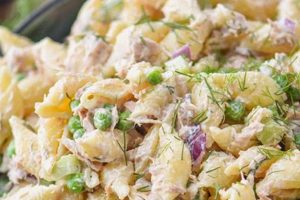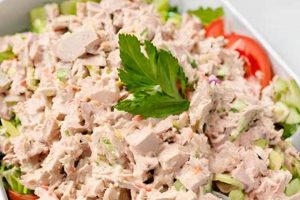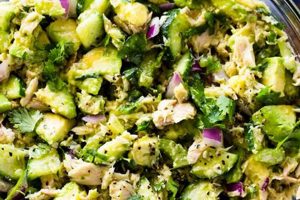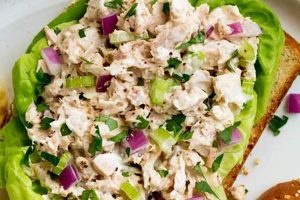A simple tuna macaroni salad combines cooked macaroni pasta with canned tuna, mayonnaise, and often celery, onion, and seasonings. Variations can include hard-boiled eggs, relish, or other vegetables. This type of dish represents a convenient and affordable meal or side dish, ideal for picnics, potlucks, or quick lunches. Its customizable nature allows for adaptations to dietary needs and preferences.
Quick-to-prepare meals and side dishes play a vital role in contemporary lifestyles. This style of salad offers a nutritious and flavorful option for those seeking convenient meal solutions without compromising taste. Historically, pasta salads gained popularity as refrigeration became more accessible, allowing for safe storage and transport of mayonnaise-based dishes. The adaptability of this dish has contributed to its sustained presence in various culinary traditions.
The following sections will explore variations on this classic dish, including ingredient substitutions for dietary restrictions, tips for enhancing flavor profiles, and suggestions for presentation and serving.
Tips for a Successful Tuna Macaroni Salad
Achieving a flavorful and well-balanced tuna macaroni salad involves attention to ingredient selection and preparation techniques. The following tips offer guidance for optimal results.
Tip 1: Pasta Perfection: Cook pasta al dente to prevent a mushy texture. Rinse cooked pasta under cold water to stop the cooking process and cool it down quickly.
Tip 2: Tuna Selection: Opt for high-quality canned tuna packed in water or oil, depending on preference. Drain the tuna well to avoid excess liquid in the salad.
Tip 3: Mayonnaise Matters: Use good quality mayonnaise as it forms the base of the dressing. Consider adding a touch of plain yogurt or sour cream for a lighter, tangier flavor.
Tip 4: Crisp Vegetables: Ensure vegetables like celery and onions are finely chopped for even distribution and optimal texture. Soaking chopped onions in cold water for a few minutes can mellow their flavor.
Tip 5: Seasoning Secrets: Classic seasonings include salt, pepper, and celery seed. Experiment with dill, paprika, or a dash of hot sauce for added depth of flavor.
Tip 6: Chill Out: Allow the salad to chill in the refrigerator for at least 30 minutes before serving. This allows the flavors to meld and enhances the overall experience.
Tip 7: Garnish and Serve: Enhance presentation with fresh herbs like parsley or chives. Serve chilled as a side dish or light meal.
By following these guidelines, one can create a tuna macaroni salad that is both delicious and satisfying. Attention to detail in ingredient selection, preparation, and chilling contributes significantly to the final product.
These practical tips provide a foundation for creating a delightful tuna macaroni salad. The following section will offer variations and suggestions for customizing the recipe.
1. Simple Ingredients
The ease of a tuna macaroni salad recipe directly correlates with the simplicity of its ingredients. Recipes emphasizing readily available pantry staples minimize preparation time and effort. Canned tuna, dried pasta, mayonnaise, and common seasonings like salt and pepper form the core components. This accessibility makes the dish practical for individuals with limited cooking experience or those seeking quick meal solutions. For example, using canned tuna eliminates the need for fresh fish preparation, while dried pasta requires only boiling. Reliance on such basic ingredients contributes significantly to the “easy” aspect of the recipe.
Furthermore, the use of simple ingredients enhances the adaptability of the recipe. Common pantry staples offer a blank canvas for culinary creativity. Additions like chopped celery, onion, or relish introduce complexity without requiring specialized ingredients or techniques. This flexibility allows for customization based on individual preferences and dietary needs. One could substitute plain yogurt for a portion of the mayonnaise to reduce fat content or incorporate different vegetables to increase nutritional value. Such modifications remain within the scope of “easy” due to the inherent simplicity of the base ingredients.
In conclusion, the emphasis on simple ingredients underscores the accessibility and adaptability of easy tuna macaroni salad recipes. This focus on basic pantry staples facilitates quick preparation and offers a foundation for personalized variations. The ease of ingredient acquisition and utilization makes this dish a practical and appealing option for a wide range of individuals and culinary contexts. The simplicity also contributes to the overall affordability of the dish, making it a budget-friendly meal solution.
2. Quick Preparation
Quick preparation is a defining characteristic of an easy tuna macaroni salad recipe. The time investment required, from ingredient assembly to final plating, significantly impacts the recipe’s overall ease and appeal. This efficiency makes the dish suitable for weeknight meals, last-minute gatherings, or situations where cooking time is limited.
- Minimal Cooking Time
Boiling the pasta is the primary cooking task, typically requiring less than 10 minutes. Other components, such as canned tuna and pre-chopped vegetables (if used), require no cooking. This minimal cooking time contributes significantly to the recipe’s overall speed and convenience. For example, compared to more elaborate pasta dishes involving homemade sauces or multiple cooking stages, tuna macaroni salad emerges as a considerably quicker option.
- Simple Ingredient Preparation
Ingredient preparation is straightforward. Opening and draining canned tuna, chopping vegetables, and measuring seasonings involve basic culinary skills. This streamlined preparation contrasts with more complex recipes requiring extensive chopping, marinating, or pre-cooking of ingredients. For instance, preparing a tuna steak for a salad would require more time and effort than opening a can of tuna.
- Fast Assembly
Once the pasta is cooked and cooled, combining it with other ingredients takes mere minutes. The simple act of mixing the components in a bowl contributes to the recipe’s overall speed and ease. This rapid assembly contrasts with recipes involving layered dishes or intricate plating techniques. Consider the difference between assembling a layered casserole versus simply tossing ingredients together in a bowl.
- No Specialized Equipment
Preparation requires no specialized equipment beyond a pot for boiling pasta, a colander for draining, and a bowl for mixing. The absence of complex tools or appliances further simplifies the process and makes the recipe accessible to a broader range of individuals. Unlike recipes requiring food processors, blenders, or specialized cookware, tuna macaroni salad relies on standard kitchen tools.
The combination of minimal cooking time, straightforward ingredient preparation, fast assembly, and lack of specialized equipment contributes directly to the “easy” classification of tuna macaroni salad recipes. This efficiency expands the dish’s appeal to individuals seeking convenient and time-saving meal solutions without compromising flavor or satisfaction.
3. Minimal Cooking
Minimal cooking is a crucial component of what qualifies a tuna macaroni salad recipe as “easy.” The reduced time and effort associated with cooking contribute significantly to the dish’s convenience and appeal, particularly for those seeking quick meal solutions or possessing limited culinary experience. This aspect directly addresses the “easy” qualifier by streamlining the preparation process and minimizing active cooking time.
- Reduced Active Cooking Time
Boiling the pasta constitutes the primary cooking requirement. This process generally takes under 10 minutes, significantly less time than many other culinary endeavors. The remaining components, such as canned tuna, mayonnaise, and pre-chopped vegetables, require no cooking whatsoever. This brevity contrasts sharply with recipes involving multiple cooking steps, extended simmering times, or complex cooking techniques. Consider the difference between a quick pasta boil and preparing a complex sauce requiring constant attention.
- Preservation of Nutritional Value
Minimal cooking helps preserve the nutritional value of the ingredients. Overcooking can deplete certain vitamins and minerals. The quick cooking time for the pasta and the absence of cooking for other components ensure that nutrients are retained to a greater extent. This benefits those seeking nutritious yet convenient meal options. For example, lightly steamed vegetables retain more nutrients compared to their boiled counterparts.
- Simplified Cleanup
Less cooking translates to less cleanup. A single pot for boiling pasta and a mixing bowl represent the primary utensils required. This minimal use of cookware simplifies the post-meal cleanup process compared to dishes involving multiple pots, pans, and utensils. The difference between washing a single pot versus an entire set of cookware highlights this advantage.
- Energy Efficiency
Minimal cooking also contributes to energy efficiency. Shorter cooking times reduce energy consumption compared to recipes requiring prolonged heating or the use of multiple appliances. This aligns with environmentally conscious cooking practices. The energy used to boil pasta for 8 minutes is considerably less than that required to roast a chicken for an hour, for example.
The convergence of reduced active cooking time, nutrient preservation, simplified cleanup, and energy efficiency underscores the significance of minimal cooking in an “easy” tuna macaroni salad recipe. These factors collectively contribute to the dish’s convenience and appeal, making it a practical and accessible option for a wide range of individuals and culinary contexts. The ease of preparation further positions tuna macaroni salad as an ideal choice for busy schedules, novice cooks, or anyone seeking a flavorful and satisfying meal with minimal effort.
4. Customizable Flavors
Customization plays a key role in the sustained popularity of easy tuna macaroni salad recipes. The ability to adapt the flavor profile to individual preferences or dietary needs enhances the dish’s versatility and broad appeal. This adaptability stems from the simplicity of the core recipe, which provides a neutral foundation for a wide range of flavor additions and modifications. Exploring the various facets of flavor customization reveals the significant connection between personalized taste and ease of preparation.
- Ingredient Swaps
Ingredient substitutions offer a primary avenue for flavor customization. Greek yogurt or light mayonnaise can replace full-fat mayonnaise to reduce fat content without compromising creaminess. Different varieties of tuna, such as albacore or yellowfin, introduce subtle flavor nuances. Beyond the core ingredients, customization extends to vegetable additions. Chopped bell peppers, red onion, or shredded carrots introduce contrasting textures and flavors. These swaps demonstrate how simple ingredient changes can significantly alter the final flavor profile.
- Seasoning Variations
Seasonings offer another layer of customization. Fresh or dried herbs like dill, parsley, or chives contribute distinct aromatic notes. Spices like paprika, cayenne pepper, or curry powder introduce varying levels of heat and complexity. Pre-made spice blends designed for fish or salads offer convenient flavor enhancements. The measured use of seasonings allows for precise flavor adjustments to suit individual palates. For example, a dash of smoked paprika can impart a smoky depth, while a pinch of cayenne pepper adds a touch of heat.
- Textural Adaptations
Texture plays a significant role in the overall sensory experience. Adding chopped nuts, such as walnuts or pecans, introduces a satisfying crunch. Crumbled bacon adds a savory, smoky element and textural contrast. Incorporating chopped water chestnuts or celery offers a refreshing crispness. These textural adaptations demonstrate how manipulating texture can enhance both the flavor and enjoyment of the salad.
- Acidic Accents
Incorporating acidic elements brightens the flavor profile and balances the richness of the mayonnaise. A squeeze of lemon or lime juice adds a citrusy tang. A splash of apple cider vinegar or white wine vinegar contributes a subtle sharpness. Chopped pickles or relish introduce a sweet and tangy dimension. These acidic accents provide a counterpoint to the creamy base and enhance the overall flavor complexity.
The inherent adaptability of easy tuna macaroni salad recipes allows for extensive flavor customization without compromising simplicity. The ease of ingredient swaps, seasoning variations, textural adaptations, and acidic accents empowers individuals to create personalized versions tailored to their specific tastes. This inherent flexibility reinforces the connection between “customizable flavors” and “tuna macaroni salad recipe easy,” highlighting the dish’s versatility and enduring appeal.
5. Budget-Friendly
Affordability represents a significant advantage of easy tuna macaroni salad recipes. The “budget-friendly” nature stems from the reliance on inexpensive, readily available ingredients. Canned tuna, pasta (especially dried), mayonnaise, and common seasonings typically fall within lower price points compared to fresh fish, specialty cheeses, or complex sauces. This accessibility contributes to the dish’s practicality for individuals or families seeking cost-effective meal solutions. For example, a household facing budgetary constraints can prepare a satisfying tuna macaroni salad for a fraction of the cost of a meal involving steak or other premium proteins. This cost-effectiveness makes the dish a viable option for stretching food budgets without sacrificing nutritional value or flavor.
Further enhancing the budget-friendly aspect is the potential to utilize leftover ingredients. Cooked pasta from a previous meal readily integrates into the salad, minimizing food waste. Similarly, incorporating leftover vegetables, such as chopped onions or bell peppers, extends their lifespan and reduces overall grocery expenses. This resourcefulness contributes to the recipe’s value proposition, demonstrating that an easy and delicious meal can emerge from readily available and sometimes overlooked ingredients. The ability to repurpose leftovers further solidifies the connection between “budget-friendly” and “tuna macaroni salad recipe easy,” showcasing its practicality and adaptability within various economic contexts.
In conclusion, the affordability of easy tuna macaroni salad recipes stems from the utilization of inexpensive core ingredients and the potential for incorporating leftovers. This cost-effectiveness makes the dish an attractive option for individuals seeking budget-conscious meals without compromising taste or nutritional value. The inherent affordability aligns with the overall “easy” nature of the recipe, as it not only simplifies preparation but also minimizes financial strain. This combination of ease and affordability contributes significantly to the dish’s enduring popularity across diverse socioeconomic backgrounds.
6. Versatile Serving
The versatility of serving options contributes significantly to the “easy” classification of tuna macaroni salad recipes. This adaptability stems from the dish’s ability to function effectively in various culinary contexts, ranging from a simple side dish to a light main course. This flexibility simplifies meal planning and reduces the need for multiple dishes, aligning with the overall convenience associated with “easy” recipes. For example, a single batch of tuna macaroni salad can serve as a side at a barbecue, a light lunch for a workday, or a component of a larger potluck spread. This adaptability eliminates the need for specialized preparations for different occasions, further underscoring the connection between “versatile serving” and “tuna macaroni salad recipe easy.”
Several factors contribute to this versatility. The salad’s temperature tolerance allows for serving chilled or at room temperature, eliminating the need for precise temperature control. This characteristic proves particularly useful for picnics, potlucks, or outdoor gatherings where maintaining specific temperatures can be challenging. Furthermore, portioning flexibility allows for adjustments based on serving size requirements. The salad can be served in individual portions for packed lunches or as a larger shared dish for family meals. This adaptability simplifies portion control and minimizes food waste. Finally, the dish’s compatibility with various accompaniments further enhances its versatility. Tuna macaroni salad pairs well with simple sides like chips, crackers, or a green salad, creating a complete meal with minimal preparation effort. This compatibility streamlines meal planning and expands serving possibilities.
In conclusion, the versatile serving options associated with tuna macaroni salad contribute directly to its classification as an “easy” recipe. The adaptability of serving temperature, portioning flexibility, and compatibility with various accompaniments simplify meal planning and broaden the dish’s applicability in diverse culinary settings. This versatility aligns with the overall emphasis on convenience and ease of preparation, solidifying the connection between “versatile serving” and “tuna macaroni salad recipe easy.” This understanding reinforces the practical value of the dish as a time-saving and adaptable meal solution for a wide range of occasions and dietary preferences.
7. Make-Ahead Convenience
Make-ahead convenience represents a significant factor contributing to the “easy” designation of tuna macaroni salad recipes. The ability to prepare the dish in advance simplifies meal planning and reduces time pressure surrounding mealtimes. This characteristic aligns with the overall emphasis on convenience and ease of preparation inherent in “easy” recipes. The following explores the facets of make-ahead convenience within the context of tuna macaroni salad.
- Reduced Mealtime Stress
Preparing tuna macaroni salad in advance alleviates mealtime stress. Having a ready-to-serve dish eliminates the need for last-minute cooking, particularly beneficial during busy schedules or when hosting gatherings. This pre-emptive approach contrasts with the time constraints and potential stress associated with preparing meals on demand. For instance, preparing the salad the night before a workday lunch eliminates morning preparation time.
- Enhanced Flavor Development
Chilling the salad for an extended period, often overnight, allows the flavors to meld and deepen. The absorption of the dressing into the pasta and other ingredients enhances the overall taste and texture. This flavor enhancement contrasts with dishes prepared immediately before serving, where flavor integration may be less pronounced. The difference between a freshly made salad and one chilled overnight exemplifies this flavor development.
- Improved Time Management
Make-ahead preparation optimizes time management by decoupling cooking from serving. This allows individuals to dedicate focused time to cooking when convenient, rather than being constrained by immediate mealtime demands. This flexibility contrasts with recipes requiring immediate preparation and serving, which can disrupt schedules. Preparing a batch of tuna macaroni salad on the weekend frees up weeknight time for other activities.
- Simplified Entertaining
Make-ahead convenience simplifies entertaining. Having a prepared dish ready to serve reduces the workload associated with hosting gatherings. This preparedness contrasts with the demands of preparing multiple dishes simultaneously immediately before guests arrive. A pre-made tuna macaroni salad allows hosts to focus on other aspects of entertaining, such as guest interaction or setting ambiance.
The convergence of reduced mealtime stress, enhanced flavor development, improved time management, and simplified entertaining underscores the significant role of make-ahead convenience in defining “tuna macaroni salad recipe easy.” This attribute expands the dish’s practicality beyond individual meals to encompass various social and culinary contexts. The ability to prepare the dish in advance aligns seamlessly with the overarching theme of ease and convenience, solidifying its position as a practical and adaptable meal solution.
Frequently Asked Questions
This section addresses common inquiries regarding easy tuna macaroni salad recipes. Clarifying these points aims to enhance understanding and facilitate successful preparation.
Question 1: What type of pasta works best?
Elbow macaroni is traditional, but other short pasta shapes like rotini, shells, or farfalle work well. Avoid long pasta strands like spaghetti or linguine, as they can be difficult to manage in a salad.
Question 2: Can the salad be made with low-fat ingredients?
Substituting plain Greek yogurt or light mayonnaise for full-fat mayonnaise effectively reduces fat content. Opting for tuna packed in water instead of oil further lowers fat. These substitutions maintain a creamy texture while reducing overall caloric intake.
Question 3: How long can the salad be stored?
Properly stored in an airtight container in the refrigerator, tuna macaroni salad typically lasts for three to five days. Discard any salad showing signs of spoilage, such as an off odor or discoloration.
Question 4: Can frozen vegetables be used?
Fresh vegetables offer superior texture and flavor. However, frozen peas or carrots can be used in a pinch. Thaw and drain them thoroughly before adding to the salad to prevent excess moisture.
Question 5: How can the salad’s flavor be enhanced?
Fresh herbs, spices, and acidic elements contribute complexity. Consider adding fresh dill, chopped celery, a squeeze of lemon juice, or a dash of hot sauce for enhanced flavor dimensions.
Question 6: Can the recipe be adapted for dietary restrictions?
Gluten-free pasta allows adaptation for gluten intolerance. Vegan mayonnaise provides a plant-based alternative. Ingredient substitutions offer flexibility for addressing various dietary needs.
Addressing these common inquiries provides a clearer understanding of the versatility and adaptability of easy tuna macaroni salad recipes. This knowledge empowers individuals to confidently prepare the dish according to their specific needs and preferences.
The following section will offer a selection of recipe variations to inspire culinary exploration.
Tuna Macaroni Salad Recipe Easy
Exploration of “tuna macaroni salad recipe easy” reveals a dish characterized by simplicity, adaptability, and affordability. Minimal cooking requirements, readily available ingredients, and versatile serving options contribute to its convenience. Customizable flavors, achieved through ingredient substitutions and seasoning variations, broaden appeal. The dish’s make-ahead potential enhances time management and simplifies meal planning. Budget-friendly ingredients and the option to utilize leftovers further enhance its practicality.
Tuna macaroni salad’s enduring presence in culinary repertoires stems from its adaptability and ease of preparation. Understanding the core components and flavor customization options allows for personalized variations while maintaining the dish’s inherent simplicity. This accessibility ensures its continued relevance as a practical and satisfying meal solution.






